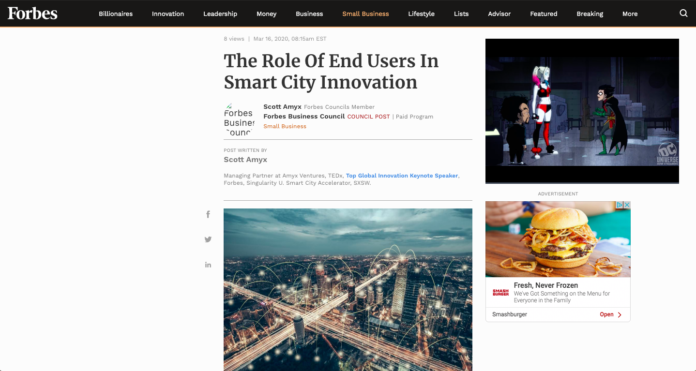





Most smart city workshops led by big consultancies move right into discussions about electric and autonomous vehicles, mass transit mobility, IoT, 5G, data, renewable energy and distributed grid, urban farming, smart buildings, innovation, and knowledge economy. But what’s often missing in these projects is the direct involvement of citizens, the end users of smart city solutions.
There is concern that smart city projects are often driven by technology- and corporate-centric narratives rather than socially inclusive innovation that addresses social, economic, demographic and environmental challenges of ever-increasing complexities of cities.
Fortunately, there is a growing interest in the notion of using cities as living labs to innovate and test solutions that can address the challenges of growing cities. The quadruple helix model presents a framework that can help achieve a more holistic and inclusive process to shape the future of cities. A recent study examines the role of academic, business, municipal and community sectors to work together to create civic-based living labs.
In theory, smart cities include a human framework that evaluates creativity, learning, humanity and knowledge components that positively impact the quality of life for its citizens and visitors. Yet, in reality, end users are rarely at the roundtable. I know, because I am often invited to these smart city initiatives composed of academics, industry experts, policymakers, municipal stakeholders and public finance professionals. Most projects try to extrapolate what the end users need through public and private data without ever involving a single end user.
Living laboratories, if properly structured, can create user-centered innovation methodology that takes a systematic approach to include users in real-life communities and settings. Living labs are testbeds or a co-creation ecosystem that invites citizens into idea generation, development and evaluation of a social or service solution. It fosters wider participation that engages different community actors in innovation activities and initiatives. The co-innovation process increases the likelihood that the solutions will be embraced by the public.
To read the full article, visit Forbes: https://www.forbes.com/sites/forbesbusinesscouncil/2020/03/16/the-role-of-end-users-in-smart-city-innovation/
About Scott Amyx
Managing Partner at Amyx Ventures, Top Global Innovation Keynote Speaker, TEDxWallStreet, Forbes, Singularity U., SXSW, IBM Futurist, Tribeca Fellow
Book Scott Today to help your organization innovate outside-of-the-box
****MORE EXCLUSIVE Content on Instagram:****
https://www.instagram.com/scott_amyx/
►Subscribe for MORE videos & podcasts!
Website: https://scottamyx.com/
YouTube: https://www.youtube.com/channel/UCNnVp5hGUCRoY-XpPDoGPMA
★↓FOLLOW ME ON SOCIAL MEDIA!↓★
Website: https://scottamyx.com/
LinkedIn: https://www.linkedin.com/in/scottamyx/
Instagram: https://www.instagram.com/scott_amyx/
Twitter: https://twitter.com/ScottSAmyx
TikTok: http://vm.tiktok.com/81Je3r/


















